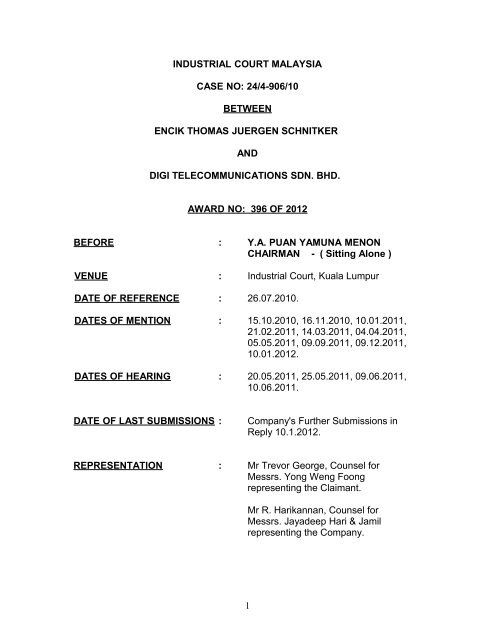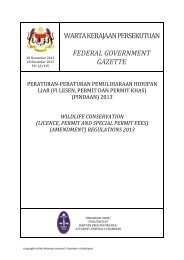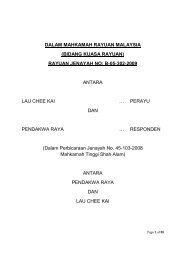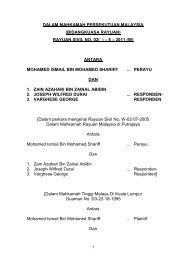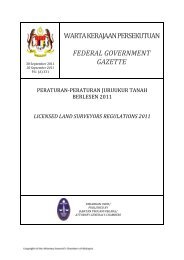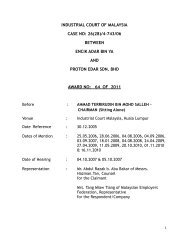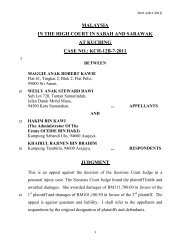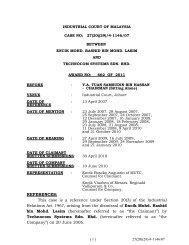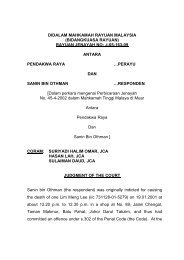industrial court malaysia - Malaysian Legal and Tax Information Centre
industrial court malaysia - Malaysian Legal and Tax Information Centre
industrial court malaysia - Malaysian Legal and Tax Information Centre
You also want an ePaper? Increase the reach of your titles
YUMPU automatically turns print PDFs into web optimized ePapers that Google loves.
INDUSTRIAL COURT MALAYSIA<br />
CASE NO: 24/4-906/10<br />
BETWEEN<br />
ENCIK THOMAS JUERGEN SCHNITKER<br />
AND<br />
DIGI TELECOMMUNICATIONS SDN. BHD.<br />
AWARD NO: 396 OF 2012<br />
BEFORE : Y.A. PUAN YAMUNA MENON<br />
CHAIRMAN - ( Sitting Alone )<br />
VENUE : Industrial Court, Kuala Lumpur<br />
DATE OF REFERENCE : 26.07.2010.<br />
DATES OF MENTION : 15.10.2010, 16.11.2010, 10.01.2011,<br />
21.02.2011, 14.03.2011, 04.04.2011,<br />
05.05.2011, 09.09.2011, 09.12.2011,<br />
10.01.2012.<br />
DATES OF HEARING : 20.05.2011, 25.05.2011, 09.06.2011,<br />
10.06.2011.<br />
DATE OF LAST SUBMISSIONS : Company's Further Submissions in<br />
Reply 10.1.2012.<br />
REPRESENTATION : Mr Trevor George, Counsel for<br />
Messrs. Yong Weng Foong<br />
representing the Claimant.<br />
Mr R. Harikannan, Counsel for<br />
Messrs. Jayadeep Hari & Jamil<br />
representing the Company.<br />
1
REFERENCE:<br />
This is a reference made under Section 20(3) of the Industrial Relations Act,<br />
1967 pertaining to the dismissal of Encik Thomas Juergen Schnitker (the<br />
Claimant) by DIGI Telecommunications Sdn. Bhd (the Respondent).<br />
AWARD<br />
This is a reference made under Section 20(3) of the Industrial Relations Act,<br />
1967 pertaining to the dismissal of Mr Thomas Juergen Schnitker (the Claimant)<br />
by DIGI Telecommunications Sdn. Bhd (the Respondent or “the Company”).<br />
The Claimant's Last Drawn Salary was RM102,850.00 (See page 33 of<br />
Company's Bundle of Documents, COB1).<br />
The Issues<br />
The Issues in this case are as follows:<br />
First Issue: Whether the dismissal was with just cause <strong>and</strong> excuse.<br />
Second Issue: Whether the Claimant's contract of employment was a fixed term<br />
contract.<br />
Third Issue: If the dismissal was without just cause <strong>and</strong> excuse, whether the<br />
Claimant should be reinstated.<br />
Fourth Issue: What would be the quantum in terms of backwages.<br />
2
The Pleadings<br />
The Pleadings in this case comprised the following:<br />
a) Statement of Case dated 15.11.2010 (“SOC”);<br />
b) Statement in Reply dated 12.2.2011 (“SIR”);<br />
c) Rejoinder dated 14.3.2011 (“Rejoinder”).<br />
The Documents<br />
The Documents pertaining to this case were as follows:<br />
a) Claimant's Bundle of Documents-1 marked as “CLB-1”;<br />
b) Company's Bundle of Documents marked as “COB-1”;<br />
c) Company's Supplementary Bundle of Documents marked as “COB-2”.<br />
The Witnesses<br />
The Witnesses were:<br />
1. The Company's sole witness Mr. Chan Nam Kiong (COW1, Witness<br />
Statement dated 25.5.2011 marked as “COW-S1”);<br />
2. The Claimant was sole witness in his case (CLW1, Witness Statement<br />
dated 25.5.2011 marked as “CLW-S1”).<br />
Claimant's Case<br />
The Contract of Employment<br />
The Claimant was appointed as the Chief Commercial/Marketing Officer<br />
(CCO/CMO) of the Company by virtue of the Letter of Offer of Employment dated<br />
3
4.4.2008 (page 20-25, Exhibit 3 attached to SOC, see also COB1 p1-6). He<br />
commenced employment on 1.5.2008.<br />
The material express terms of employment are as expressed in the Offer of<br />
Employment which the Claimant signed <strong>and</strong> accepted on 7.4.2008. This<br />
document stipulates his basic monthly salary <strong>and</strong> contractual benefits as follows:-<br />
a) Performance bonus;<br />
b) Special Incentive;<br />
c) Housing;<br />
d) Company Car;<br />
e) Children Education Expenses;<br />
f) Home Leave;<br />
g) Club Membership;<br />
h) Relocation Expenses;<br />
i) Australian Medical Benefits for Wife; <strong>and</strong><br />
j) Employee Provident Fund (EPF).<br />
Claimant's Task<br />
It was submitted on behalf of the Claimant that he was given the mission, as<br />
one of the four (4) top Management Officers/Chiefs “to bring change to the<br />
Company owing to the insufficiencies it faced at the material time” (para 7 SOC<br />
<strong>and</strong> para 5 SIR, see also COB p7-8, ”Main objectives <strong>and</strong> responsibilities of the<br />
Claimant”, <strong>and</strong> Q & A 4 - 7, CLWS1).<br />
The mission entrusted to him by the Ex-Chief Executive Officer of the Company<br />
(“the Ex-CEO”) Johan Dennelind, is reflected in the Memo dated 16.4.2008 from<br />
4
Bjorn Magnus Kopperud to him (page 26, documents attached to the SOC) <strong>and</strong><br />
the Ex-CEO's Write-Up of his expectations (pages 27-29, documents attached to<br />
the SOC).<br />
The Claimant pointed out that throughout his tenure with the Company, he had<br />
achieved milestones for the Company (see paragraph 8, SOC <strong>and</strong> also<br />
Claimant's testimony Q&A 13, CLW-S1). In other words the Claimant's position<br />
was that he had contributed much to the Company <strong>and</strong> there certainly were no<br />
performance issues as claimed by the Company in the termination letter.<br />
The Termination<br />
The Claimant was h<strong>and</strong>ed a Letter of Termination of Contract dated 9.7.2009<br />
terminating his contract with immediate effect (pages 18-19, Exhibit 2, SOC, see<br />
also COB1 p31-32).<br />
The letter reads as follows:<br />
“Dear Tom,<br />
Termination of Contract<br />
Reference is made to the above matter. We wish to advise that we hereby<br />
exercise our right under the terms of your contract to terminate your services for<br />
cause. Accordingly we hereby pay you 3 months salary in lieu of 3 months<br />
notice.<br />
We wish to advise that we have made this decision after consulting with you <strong>and</strong><br />
after making reasonable efforts to establish a viable alternative course of action.<br />
However it is evident that these efforts which have been undertaken in good faith<br />
have proven to be abortive.<br />
5
Our decision to terminate your contract is premised on the following:-<br />
1. We have examined your performance in the position of Chief Commercial<br />
Officer <strong>and</strong> measured the same against the job size <strong>and</strong> deliverables. It is<br />
evident to us that either your performance does not meet the expectations<br />
of the Company in terms of the market position we seek or there is a need<br />
for us to review the viability of the said position <strong>and</strong> to approach the<br />
marketing requirements <strong>and</strong> solutions differently. The details of this have<br />
been discussed previously <strong>and</strong>/or are a matter of record.<br />
2. We have taken the above into account during the general review of the<br />
organizational structure. In line with the above we have decided to devolve<br />
the commercial <strong>and</strong> marketing functions. It is our view that these steps are<br />
necessary in order to provide a more effective marketing <strong>and</strong> commercial<br />
solution. It is clear to us that the current arrangements do not adequately<br />
meet the Company's requirements in a market environment that is only<br />
expected to become more <strong>and</strong> more challenging in the foreseeable future.<br />
3. As a result of this review we have decided to abolish the position of Chief<br />
Commercial Officer in its present form.<br />
4. We had attempted to explore alternative positions with you <strong>and</strong> this had<br />
been communicated previously with. It is evident that these have been<br />
rejected. We deny the suggestion that this was put to you out of the blue<br />
<strong>and</strong> we are unable to agree with your characterization of your performance<br />
which does not represent the true position. It is our position that you have<br />
been duly appraised of the unfolding events that have culminated in the<br />
above decision.<br />
6
We wish you well in your further undertakings. Kindly liaise with the Head of<br />
HRD to facilitate the h<strong>and</strong>over of company belongings <strong>and</strong> outst<strong>and</strong>ing<br />
assignments.<br />
Please be advised accordingly,<br />
Johan Dennelind<br />
CEO”<br />
The said letter stated the reasons for the termination as follows:-<br />
1. the Company's restructuring that led to the Claimant's position being<br />
abolished <strong>and</strong><br />
2. poor performance on the part of the Claimant.<br />
First Issue: whether the dismissal was with just cause <strong>and</strong> excuse<br />
The Law<br />
It is trite law that the Company does not have the right to terminate the services<br />
of the Claimant for no valid reason.<br />
In Tip Top Motorcade Sdn. Bhd. v. Johnny Chong Choong Keong (Award<br />
114 of 1994), the learned Chairman of the Industrial Court stated the basic<br />
principles as follows:-<br />
“The Industrial Court is obliged to act upon the evidence <strong>and</strong> on the basis of<br />
settled principles of <strong>industrial</strong> jurisprudence. In particular, it takes into account<br />
these well-established principles of <strong>industrial</strong> law:<br />
7
(a) That in order to safeguard a workman's security of tenure, a dismissal<br />
must be grounded on just cause or excuse (Dr. A. Dutt v Assunta<br />
Hospital [1981] 1 MLJ 304).<br />
(b) That there is no material difference between a termination <strong>and</strong> a dismissal.<br />
And further:<br />
The term employed in the act of bringing a workman's employment to an<br />
end is inconsequential; it is the Court's duty to determine whether that act,<br />
whatever the label attached to it, was for just cause or excuse.”<br />
“ (d) That the burden of proof of the facts which would constitute just<br />
cause or excuse is on the employer. The employer discharges his<br />
burden by adducing evidence either oral or documentary, to prove<br />
the facts which he alleges as constituting just cause or excuse.<br />
(e) That the Court's duty is to enquire whether the reason or excuse<br />
advanced by the employer has or has not been made out. If the Court<br />
finds as a fact that it has not been proven, then the inevitable conclusion<br />
must be that the termination or dismissal was without just cause or<br />
excuse.”<br />
Claimant's Arguments<br />
The Claimant submitted that the Company had terminated his employment<br />
simpliciter under the guise of poor performance <strong>and</strong> restructuring.<br />
The Claimant pointed out that after the fact of termination on 9.7.2009, the<br />
Company alleged other “grounds” for the Claimant's dismissal, such as,<br />
8
'misbehaviour', 'inappropriate behaviour', 'detrimental to ...reputation' <strong>and</strong>/or<br />
'abuse of trust <strong>and</strong> confidence' (paragraphs 15, 16, 17 <strong>and</strong> 23 of the SIR).<br />
It was submitted on behalf of the Claimant that at no time did these allegations<br />
feature as part of the Company's grounds for termination as stated in its<br />
Letter of Termination dated 9.7.2009 (page 18-19, Exhibit 2, SOC).<br />
Company Witness<br />
The CEO Johan Dennelind, who had issued the letter of termination did not come<br />
as a witness. Instead the Company relied solely on the evidence of the<br />
Claimant's subordinate Mr. Chan Nam Kiong (“COW-1”), the Company's sole<br />
witness who obviously had no personal knowledge pertaining to the Claimant's<br />
termination. As aptly pointed out by Claimant's Counsel, his evidence was purely<br />
based on his opinion <strong>and</strong>/or view.<br />
His evidence under cross examination was as follows:<br />
“Q : Prior to the Claimant's termination, you were not in the Digi<br />
A : Agree.<br />
Management Team?<br />
Q : In terms of the hierarchy, you have the following:<br />
CEO<br />
A : Yes.<br />
CTO (Chief Technology Officer)<br />
CFO (Chief Financial Officer)<br />
CMO/CCO (Chief Marketing Officer / Chief Commercial Officer)<br />
(Claimant)?<br />
9
Q : These 4 C's are part of the DMT?<br />
A : Yes.<br />
Q : But the rest of the DMT is not from the C's?<br />
A : That's right.<br />
Q : Before the Claimant was terminated, <strong>and</strong> you were not part of<br />
A : Yes.<br />
the DMT, Management decisions pertaining to the positions<br />
<strong>and</strong> the running of the Company would have been done by the<br />
DMT members?<br />
Q : You would not be able to give evidence on the policy decisions<br />
as considerations made by the Company pertaining to the<br />
Claimant's termination?<br />
A : I have no information on the decision.”<br />
It is evident from the above that COW1 had no personal knowledge pertaining to<br />
the decision to terminate the Claimant. COW1 agreed in cross examination that<br />
the Ex-CEO, Mr. Johan Dennelind was the one person who was in a position to<br />
throw some light on the decision to dismiss.<br />
COW1 testified as follows:<br />
“Q : Mr. Johan Dennelind was supposed to come but he is not coming?<br />
A : I was made aware that he can't come.”<br />
10
Decision on the First Issue<br />
The burden of proof is on the Company to prove that the dismissal of the<br />
employee is with just cause or excuse which the Company has failed to do<br />
in this case.<br />
As observed in the Tip Top Motorcade case, “the burden of proof of the facts<br />
which would constitute just cause or excuse is on the employer. The employer<br />
discharges his burden by adducing evidence either oral or documentary, to prove<br />
the facts which he alleges as constituting just cause or excuse”<br />
In our case the reasons given for the dismissal were that the Company's plans<br />
of restructuring had led to the Claimant's position being abolished <strong>and</strong> also poor<br />
performance on the part of the Claimant. The Company's sole witness, COW1,<br />
who acknowledged that the Claimant had been his boss, confirmed under oath<br />
that he had no personal knowledge or information pertaining to the reasons for<br />
the dismissal in question.<br />
The inevitable conclusion is that the dismissal of the Claimant was without just<br />
cause or excuse.<br />
The Court has carefully <strong>and</strong> meticulously considered <strong>and</strong> evaluated the totality of<br />
the evidence before it on a balance of probabilities, bearing in mind s 30(5) of the<br />
IR Act 1967. Having considered all the facts, the totality of the evidence both oral<br />
<strong>and</strong> documentary <strong>and</strong> the submissions, <strong>and</strong> being guided by the principles of<br />
equity <strong>and</strong> good conscience <strong>and</strong> the substantial merits of the case, without<br />
regard to technicalities <strong>and</strong> legal form, this Court finds that the dismissal of the<br />
Claimant in this case was without just cause <strong>and</strong> excuse.<br />
11
Second Issue: Whether the contract of employment is a fixed term contract<br />
The Pleading Issue<br />
Neither the Claimant nor the Company in this case pleaded the issue of fixed<br />
term contract in their respective pleadings.<br />
IN the case R. Rama Ch<strong>and</strong>ran v The Industrial Court Malaysia & Anor<br />
(1997) 1 MLJ 145, it was held that:<br />
“It is trite law that a party is bound by its pleadings. The Industrial Court must<br />
scrutinize the pleadings <strong>and</strong> identify the issues, take evidence, hear the<br />
parties' arguments <strong>and</strong> finally pronounce its judgment having strict regards to<br />
the issues.”<br />
The Company submitted that it was the Claimant's burden to plead (<strong>and</strong><br />
prove) that his contract was permanent <strong>and</strong> not a genuine fixed-term<br />
contract.<br />
It was argued on behalf of the Company that the Claimant had failed to plead<br />
that he was not on a fixed term contract <strong>and</strong> that instead his employment was on<br />
a permanent basis.<br />
The case of Pernas OUE (KL) Sdn Bhd v Choi Wai Ki [1997] 2 ILR 439 was<br />
referred to, where the Court held:-<br />
“Furthermore the Court agrees with the Company that the contention of the<br />
Claimant that he was on a permanent contract was not pleaded.<br />
12
It was argued on behalf of the Claimant as follows:<br />
It was pointed out on behalf of the Claimant that the issue here is as to who is<br />
relying on the fixed term employment contract. It was argued that the Claimant<br />
is not relying on it but the Company is, especially to pre-empt any issue of<br />
reinstatement.<br />
It was submitted further that as the primary remedy under s.20 IRA 1067 is<br />
reinstatement, it must follow that it is for the Company to plead, or lead evidence<br />
on it being a fixed-term.<br />
The Claimant also submitted that it is trite law that he who asserts must prove<br />
(S.101&102 evidence Act 1950).<br />
Hence it was submitted that as it is the Company that is alleging the fixed term, it<br />
is incumbent on them to plead, <strong>and</strong> prove.<br />
The Court's View<br />
The Court is of the view that the failure to plead this issue as a specific item is<br />
not fatal in this case. Although it would have been far better for this fact to have<br />
been addressed specifically by the Claimant in the SOC <strong>and</strong> then responded to<br />
in reply in the SIR by the Company, the failure to plead this is not fatal. It must<br />
not be forgotten that the Claimant's claim seeks for reinstatement as a remedy,<br />
<strong>and</strong> in lieu of it, compensation. The facts (whatever facts are available) are<br />
before this Court to decide.<br />
Furthermore the Company in its Statement in Reply would normally address<br />
issues raised by the Claimant in the Statement of Case (SOC).<br />
13
It is after all a Reply. The Claimant failed to plead in the SOC the issue that his<br />
was not a genuine fixed term contract <strong>and</strong> the Company did not address this<br />
issue in the SIR. Such failure in this case is not fatal to either party.<br />
The Han Chiang Principle<br />
In M Vasagam a/l Muthusamy v Kesatuan Pekerja-Pekerja Resort World,<br />
Pahang & Anor [2003] 5 MLJ 262. the Industrial Court dealt with the issue of<br />
whether the contract of employment was a genuine fixed term contract. The<br />
applicant in that case relied on the case of Han Chiang School, Penang Han<br />
ChiangAssociated Chinese Scholls Association v National Union of<br />
Teachers in independent Schools, W Malaysia [1988] 1 ILR 611 (“the Han<br />
Chiang case”). In the Han Chiang case the Industrial Court held that the system<br />
of fixed term contracts in the school was employed as a means of control of the<br />
teachers concerned. The intention of the school was to rid itself of the union,<br />
Hence the school relied on the fixed term contracts to get rid of the teachers who<br />
were members of the union. The Court held on the facts that the contracts of<br />
employment were not genuine fixed term contracts. In this case some of the<br />
teachers had taught at the school for more than 20 years <strong>and</strong> “had their<br />
contracts renewed unfailingly during those years without the need to<br />
reapply whenever their fixed term contracts expired. The teachers<br />
therefore claimed that they had the right to automatic renewals of their<br />
contracts upon their expiry because all along that had been the practice of<br />
the school in the past”.<br />
14
The principle in Han Chiang appears to be that there must be clear facts to<br />
establish permanency of employment <strong>and</strong> to rebut the outward appearance of<br />
the fixed term nature of the contract. The Han Chiang situation is the exception<br />
to the rule.<br />
The Han Chiang case was distinguished in M Vasagam case. The Industrial<br />
Court in M Vasagam case upon examining the facts of the case found that<br />
there was a genuine fixed term contract.<br />
Fixed Term -The Arguments<br />
Burden of Proof<br />
The Company submitted that it was the Claimant's burden to prove that his<br />
contract was permanent <strong>and</strong> not a genuine fixed-term contract.<br />
The Claimant submitted that the burden was on the Company to adduce<br />
evidence to show that it was a genuine fixed-term contract.<br />
The Court is of the view that it is the duty of the Court to ascertain from the<br />
facts before it whether the case comes within the exceptional situation as<br />
in Han Chiang case. There must be clear facts to establish permanency of<br />
employment <strong>and</strong> to rebut the outward appearance of the fixed term<br />
nature of the contract.<br />
The Claimant's Arguments<br />
It was submitted on behalf of the Claimant that it was not the intention of the<br />
parties that the Claimant's employment with the Company was to be only for a 2<br />
15
years fixed term. It was submitted that although the Claimant's contract was<br />
stipulated to be for 2 years, it was a permanent contract in disguise. According to<br />
the Claimant he was assured by the Company's HR Head, <strong>and</strong> the Ex-CEO of<br />
this .<br />
The Claimant also pointed out that he was “head-hunted” from his previous<br />
position in Maxis to join the Company (Q&A 4, CLWS-1) to bring change.<br />
According to the Claimant he was even promised the possibility of being CEO<br />
after a stint as CMO. The Memo dated 16.4.2008 from Bjorn Kopperud (p.26,<br />
Exh 4, SOC) was referred to where it was stated “As CMO in Digi Tom will be<br />
part of the yearly processes. If his performance <strong>and</strong> potential proves good<br />
Telenor has the intention to find other challenges/roles for Tom in<br />
accordance with his ambitions <strong>and</strong> preferences <strong>and</strong> Telenor needs”.<br />
The Court noted that there were several contingencies. It was not a sure<br />
thing both ways, meaning for the employer <strong>and</strong> the employee.<br />
The Court finds that the above statements are not sufficient to establish that the<br />
parties had really intended permanency in the employment relationship. These<br />
matters are not sufficient to prove that it was not a genuine fixed term contract.<br />
The Decision on the Second Issue<br />
Whether the Claimant's contract of employment was a fixed term contract:<br />
The Court finds that in this case, based on the facts, it was a genuine fixed term<br />
contract .<br />
16
Third Issue: If the dismissal was without just cause <strong>and</strong> excuse, whether<br />
the Claimant should be reinstated<br />
Reinstatement -The <strong>Legal</strong> Principles<br />
1. Claimant being a foreigner is not a bar to reinstatement. This was made<br />
clear by the Federal Court in Assunta Hospital v Dr. A.Dutt (1981) 1 MLJ<br />
105 [TAB B of Claimant's Additional Bundle of Authorities], where the Court<br />
held that:<br />
“As for the non-citizens status of Dr. Dutt, we share the astonishment of<br />
the judge at the relevance of this point. Our views can be stated shortly,<br />
whether Dr. Dutt can get an extension of his visit-pass so as to be able to<br />
say in this country or the issue of a work-permit in order to be able to take<br />
up the appointment are not matters that can influence the Court in proper<br />
exercise of the jurisdiction conferred on it by the minister's reference of<br />
the representations for reinstatement. If an order is made ordering<br />
reinstatement <strong>and</strong> the workman is unable to obtain either the visit-pass or<br />
the work permit, the employer would not be in contempt of the order. It is<br />
for the workman to make the order effective. All that the hospital had to<br />
do is to make the post available to the workman. As for any suggestion<br />
that the order for reinstatement would influence the ministry of Home<br />
Affairs to issue the visit-pass or the work permit, there cannot be any truth<br />
in it, <strong>and</strong> it cannot possibly be said that the ministry of Home Affairs is<br />
bound to comply with the order for instatement. In any event, it is of no<br />
concern to the hospital.”<br />
17
In the case of Dr. A Dutt, the Court weighed the evidence carefully <strong>and</strong> ordered<br />
for the Claimant to be reinstated.<br />
In Microsoft Malaysia Sdn Bhd v Michael Brian Davis [2002] 2 ILR 453 it was<br />
held:<br />
“The Industrial Court has jurisdiction to order reinstatement to a foreigner if at the<br />
end of the day, the <strong>court</strong> comes to the finding that his dismissal is without just<br />
cause <strong>and</strong> excuse. Section 20 of the Industrial Relations Act 1967 applies to all<br />
workers be they <strong>Malaysian</strong>s or foreigners”.<br />
Reinstatement is intended to restore the status quo prior to dismissal (See<br />
Kumpulan Jerai Sdn. Bhd., Rengam v. National Union of Plantation<br />
Workers & Anor [1993] 3 MLJ 221, 238 <strong>and</strong> also Harris Solid State (M) Sdn.<br />
Bhd. & Ors. v. Bruno Gentil Pereire & 21 Ors. [1996] 4 CLJ 747).<br />
It is trite law that reinstatement is the primary remedy for unjustified dismissal.<br />
In Kumpulan Peransang Selangor Bhd. v. Zaid bin Haji Mohd Noh [1997] 1<br />
AMR 1008 at (page 1033) the Federal Court referred to Malhotra's “The Law of<br />
Industrial Disputes, Fourth edition, Volume 2 page 942 (to be referred to as<br />
Malhotra) where it was stated:-<br />
“In each case, keeping the objectives of <strong>industrial</strong> adjudication in mind, <strong>and</strong> in a<br />
spirit of fairness <strong>and</strong> justice, the Tribunal has to deal with the question, whether<br />
the circumstances of the case require that an exception should be made <strong>and</strong><br />
compensation would meet the ends of justice. If, on taking these principles <strong>and</strong><br />
18
the relevant factors into consideration, the Tribunal comes to the conclusion that<br />
reinstatement would not be desirable or expedient in the circumstances of the<br />
case, it may Award compensation instead of reinstatement to the workman in<br />
spite of the fact that his discharge or dismissal was invalid owing to some<br />
infirmity in the impugned order”.<br />
In Fung Keong Rubber Manufacturing (M) Sdn. Bhd. v. Lee Eng Kiat & Ors<br />
[1981] 1 MLJ 238, the Federal Court observed:<br />
“Reinstatement, a statutorily recognized form of specific performance, has<br />
become a normal remedy <strong>and</strong> this coupled with a full refund of his wages could<br />
certainly far exceed the meagre damages normally granted at common law. The<br />
speedy <strong>and</strong> effective resolution of disputes or differences is clearly seen to be in<br />
the national interest, but it is also apparent that any attempt to impose a legal<br />
obligation without a prior exploration for a voluntary conciliation could aggravate<br />
rather than solve the problem. To this end the Director General is empowered by<br />
section 20 of the Act to offer assistance to the parties to the dispute to expedite a<br />
settlement by means of conciliatory meetings”.<br />
Reading Malhotra further at page 941, the following passage states the matter<br />
clearly:-<br />
“No hard <strong>and</strong> fast rule can however be laid down for the exercise of the discretion<br />
of the Tribunal, as in each case, it must, in a spirit of fairness <strong>and</strong> justice in<br />
keeping with the objective of <strong>industrial</strong> adjudication, decide whether it should, in<br />
the interest of justice, depart from the general rule. Fair play towards the<br />
19
employee on the one h<strong>and</strong>, <strong>and</strong> interest of the employer including the<br />
consideration of discipline in the establishment, on the other, require to be duly<br />
safeguarded. This is necessary in the interest of both security of tenure of the<br />
employee <strong>and</strong> smooth <strong>and</strong> harmonious working of the establishment. Legitimate<br />
interest of both of them have to be kept in view, if the order is expected to<br />
promote the desired objectives of <strong>industrial</strong> peace <strong>and</strong> maximum possible<br />
production. Proper balance has to be maintained between the conflicting claims<br />
of the employer <strong>and</strong> the employee without jeopardising the larger interests of<br />
<strong>industrial</strong> peace <strong>and</strong> progress”.<br />
The Court at this juncture would like to reiterate what it observed in the case of<br />
Teh Cheng Hock v Lilly Industries Sdn Bhd, Award 209 of 2010, that in<br />
making its decision “the Court has to bear in mind the need to maintain this<br />
proper balance between the conflicting claims. The reality of the present day<br />
situation is that whilst it is true that it was intended that the primary remedy for<br />
unjust dismissal is reinstatement, it cannot be denied that the reality is that it is<br />
no longer the usual remedy”.<br />
In the oft quoted case of Nestle Food Storage (Sabah) Sdn. Bhd. v. Terrence<br />
Tan Nyang Yin [2002] 1 ILR page 283 (Nestle case) the Industrial Court (Y.A.<br />
Lim Heng Seng, since retired) made a pertinent observation that reinstatement<br />
though being the primary remedy under the law, was no longer the usual remedy<br />
<strong>and</strong> that there were valid reasons for this. Making reference to the Court of<br />
Appeal decision of Koperasi Serbaguna (quoted above) in which the Court of<br />
20
Appeal had observed that in <strong>industrial</strong> jurisprudence, reinstatement is the usual<br />
or primary remedy, Y.A. Lim Heng Seng (at that time) made the observation that<br />
the principle that reinstatement is the primary remedy must “be seen in the<br />
context of the statutory emphasis on expedition in the conciliation process <strong>and</strong><br />
the stipulation of the statutory aspiration for the conclusion of the adjudication<br />
without delays <strong>and</strong> where practicable within 30 days of the reference to the<br />
Court. It cannot be gainsaid that Parliament did not contemplate that the whole<br />
process will take too much time, <strong>and</strong> that hence the expediency of the remedy of<br />
reinstatement would not be negated by long delays in the dispute resolution<br />
processes provided by the Act”.<br />
He went on to observe that “in practice, reinstatement in <strong>industrial</strong> adjudication is<br />
no longer the normal, or the usual <strong>and</strong> the general remedy regularly granted by<br />
the Court”.<br />
Hence in making its decision the Court has to bear in mind the need to maintain<br />
this proper balance between the conflicting claims.<br />
The reality of the present day situation is that whilst the primary remedy for<br />
unjust dismissal is reinstatement, it cannot be denied that it is no longer<br />
the usual remedy.<br />
As observed by this Court in the case of Teh Cheng Hock v Lilly Industries<br />
Sdn Bhd, Award 209 of 2010:<br />
21
“It is clear therefore that in reality reinstatement is not readily granted for various<br />
reasons. It is granted only in fit <strong>and</strong> proper cases. In deciding this issue, there is<br />
no hard <strong>and</strong> fast rule of universal application. In each case, keeping the<br />
objectives of <strong>industrial</strong> adjudication in mind, <strong>and</strong> in a spirit of fairness <strong>and</strong> justice,<br />
bearing in mind that a proper balance between the conflicting claims of employee<br />
<strong>and</strong> employer needs to be maintained, the Industrial Court should decide as to<br />
the appropriate remedy to be granted in each case”.<br />
The Company in its Submissions in Reply dated 10 January 2012 stated<br />
that reinstatement was not appropriate for several reasons including the<br />
fact that the Claimant's position prior to his termination was a very senior<br />
position as the Chief Commercial/Marketing Officer (CCO/CMO) of the<br />
Company.<br />
In cases where reinstatement was not granted, among the factors taken<br />
into account was the fact that the Claimant was in a high ranking or<br />
managerial position:-<br />
In Jutajaya Holding Bhd v. Lim Poh Sim Award 397 of 2007 for instance, the<br />
Chairman of the Industrial Court at that time, Y.A. Puan Amelia Tee (presently in<br />
the High Court), stated the following:-<br />
“The Court has carefully considered the question of whether reinstatement would<br />
be the correct remedy in this case. It must be borne in mind that at the time of<br />
her dismissal, the Claimant was the CEO of the Company. It need not be<br />
22
gainsaid that this is a very senior position”. The above statement underlines the<br />
fact that the position of the Claimant in a management position or senior position<br />
is an important <strong>and</strong> relevant consideration.<br />
In Gold Coin Specialities Sdn. Bhd. v. Matheswaran a/l Paspanathan [2004]<br />
3 MLJ, the High Court (on judicial review), observed that the Claimant's position<br />
was a high ranking one. It also noted that the post he had earlier held in the<br />
Company had been filled up as the Company could not be expected to keep the<br />
position vacant for a long period as it would be detrimental to the Company's<br />
operation. The High Court also observed that the Claimant was relatively young<br />
<strong>and</strong> able. These were all relevant factors to be taken into account in considering<br />
whether to grant reinstatement in any particular case.<br />
Decision On The Issue of Reinstatement<br />
This Court finds that in our case reinstatement is clearly not the appropriate<br />
remedy. The Court has considered all the relevant factors, including the<br />
Claimant's length of service in the Company, his position being a top position,<br />
the intervening period after the dismissal etc. Bearing in mind the objectives of<br />
<strong>industrial</strong> adjudication <strong>and</strong> the competing claims of employer <strong>and</strong> employee, <strong>and</strong><br />
the need to maintain the proper balance, in the spirit of fairness <strong>and</strong> justice,<br />
bearing in mind s.30(5) of the IRA, this Court is of the considered view that<br />
reinstatement is not the appropriate remedy in this case.<br />
23
Fourth Issue: What would be the quantum in terms of backwages.<br />
Remedy: The Practice<br />
In the Industrial Court case of Coca-cola Far East Limited (<strong>Malaysian</strong> Branch)<br />
v. Warren J Carey [2006] 4 ILR p 2399, the Industrial Court Chairman, Y.A.<br />
Tuan Franklin Goonting (since retired), observed:-<br />
“...it has been the normal practice of the <strong>court</strong>, where reinstatement is not<br />
ordered, to award backwages limited to twenty-four months <strong>and</strong> compensation in<br />
lieu of reinstatement at the rate of one month's salary for each completed year of<br />
service.”<br />
In that case the Claimant who was an expatriate, had sought compensation<br />
based on various contractual terms. The learned Chairman made the following<br />
pertinent observations:<br />
“In seeking the other items of relief the Claimant is in fact asking the <strong>court</strong><br />
to enforce contractual terms <strong>and</strong> conditions <strong>and</strong> to assess loss of income<br />
or damages, something within the province of the civil <strong>court</strong>s.<br />
The learned Chairman went on to say:<br />
“If all these other remedies sought by the Claimant were granted by this Court<br />
the effect would be to convert the Industrial Court into a civil <strong>court</strong> <strong>and</strong> the word<br />
“reinstatement” inserted into the statement of case would be reduced to a mere<br />
password to gain entry to the IRA system <strong>and</strong> thereafter seek civil remedies.”<br />
The above observation is clearly a pertinent one. This Court is in full<br />
agreement.<br />
24
In Robert John Reeves v Southern Bank Bank Berhad [2010 2 LNS 1608]<br />
the Industrial Court held that “the <strong>court</strong> states that it does not think that it is<br />
proper that the Claimant should be allowed his prayer for all other contractual<br />
benefits that was accorded to him in the form of housing allowances,<br />
performance based rewards <strong>and</strong> other benefits as claimed pursuant to Clause<br />
28 of his statement of case'.<br />
Issue Of Bonus<br />
a) In the case of UMW Toyota (M) Sdn. Bhd. v. Chow Weng Thiem [1996]<br />
5 MLJ 678, the High Court held as follows:<br />
“A bonus is a gift or gratuity as a gesture of goodwill, <strong>and</strong> not<br />
enforceable, or it may be something which an employee is entitled to on<br />
the happening of a condition precedent <strong>and</strong> is enforceable when the<br />
condition is fulfilled. But in both cases it is something in addition to or in<br />
excess of that which is ordinarily received. Since bonus was a form of<br />
gratuitous payment of a discretionary nature, the respondent was not<br />
entitled to it as of right.”<br />
b) In the Industrial Court's case of Felda Palm Industries Sdn. Bhd. v.<br />
Mansor Pratiman [2006] 2 LNS 0948, the <strong>court</strong> followed <strong>and</strong> affirmed the<br />
above case of UMW Toyota (M) Sdn. Bhd.:<br />
'In the case of UMW Toyota (M) Sdn. Bhd. v. Chow Weng Thiem<br />
(1996) 5 MLJ 678. His Lordship Abdul Malik J. said, “In my judgment<br />
bonus was a form of gratuitous payment of a discretionary nature, the<br />
respondent was not entitled to it as of right”. This Court agrees with the<br />
25
views of his Lordship <strong>and</strong> also the contention of the Company's Counsel in<br />
that it is the prerogative of the Company to declare bonus for its workers<br />
or employees.'<br />
It was submitted that bonus was not a benefit which the Claimant was entitled to<br />
claim as of right. Bonus was discretionary <strong>and</strong> based upon the performance of<br />
the Company <strong>and</strong> the Claimant, <strong>and</strong> the Claimant was not entitled to bonus as of<br />
right.<br />
The Court agrees with Company's submissions that indeed bonus was<br />
discretionary <strong>and</strong> that the Claimant was not entitled to it as of right.<br />
Fixed Term<br />
The unexpired period of his fixed term contract.<br />
On the issue of backwages, the Company submitted a number of cases, all of<br />
which were fixed term contract cases. The Company submitted that any<br />
exposure would be the balance of the unexpired portion or balance of the<br />
contract period .<br />
a) In the case of Ranhill Worley Sdn Bjd. (formerly known as Jacobs<br />
Construction Management (M) Sdn Bhd.) v. Franz Jozef Marie<br />
Schefman & Anor [2008] 6 MLJ 823, the Court noted the following:<br />
“There is a consistent trend of cases which decided that an<br />
expatriate who had been unfairly dismissed was awarded backwages for<br />
the unexpired period of his fixed term contract. In the present case it<br />
26
was only reasonable that the first respondent be awarded backwages for<br />
the remainder of the unexpired term of his fixed term contract, which was<br />
what the chairman of the Industrial Court did.”<br />
b) In the case of Shapadu Energy & Engineering SB b. Stuart Ashley<br />
Eban [1999] MLJ 250, the High Court affirmed the decision of the<br />
Industrial Court as follows:<br />
“The Court holds that it is a breach of the Company to disallow the<br />
Claimant to work out of the unexpired duration of the twelve months fixed<br />
term contract.<br />
Therefore, the Claimant's remedy in this dispute is the<br />
unexpired period of his fixed term contract. There is no question of<br />
reinstatement. This Court will only make an order of compensation of loss<br />
of employment from the date of termination to the expiry date of the twelve<br />
months' contract.”<br />
The Company has submitted (paragraphs 48 to 57, Company's Submission) that<br />
the Claimant should only be awarded 10 months back-wages (i.e the balance of<br />
his unexpired contract period). Their reasoning is that it's fixed-term contract<br />
(Exh 3, SOC), which contract, on the face of it, stipulates “Your employment<br />
shall start on 1 May 2008 <strong>and</strong> shall be for a period of two (2) years from the<br />
start date”.<br />
Payment of 3 months salary<br />
When the Claimant's employment was terminated he was paid a payment of 3<br />
month's salary in lieu of 3 months notice, which will be deducted.<br />
27
Remedy<br />
Having considered all the relevant factors, this Court awards the following:-<br />
1. Backwages:<br />
RM 102,850.00 x 7 months - RM 719,950.00<br />
Deduction<br />
1% deduction for post dismissal earnings:<br />
1 x RM 719,950.00 - RM 7,199.50<br />
100<br />
The total sum to be paid is RM 719,950.00 – RM 7,199.50 = RM 712,750.50<br />
The total sum of RM 712,750.50 less any statutory deductions shall be paid to<br />
the Claimant through his solicitors within 30 days from the date of service of this<br />
Award.<br />
HANDED DOWN AND DATED THIS DAY 22 TH OF MARCH 2012<br />
sgd<br />
( YAMUNA MENON )<br />
CHAIRMAN<br />
INDUSTRIAL COURT, MALAYSIA<br />
KUALA LUMPUR<br />
28


